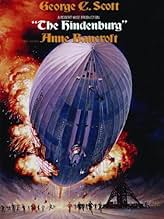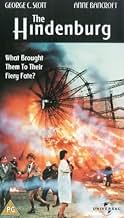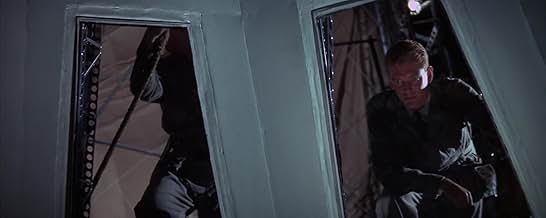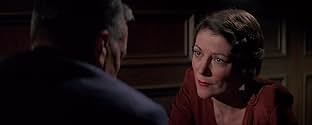NOTE IMDb
6,3/10
6,9 k
MA NOTE
Un film qui raconte les événements de la catastrophe du Hindenburg lors de laquelle un dirigeable s'est enflammé.Un film qui raconte les événements de la catastrophe du Hindenburg lors de laquelle un dirigeable s'est enflammé.Un film qui raconte les événements de la catastrophe du Hindenburg lors de laquelle un dirigeable s'est enflammé.
- Réalisation
- Scénario
- Casting principal
- Nommé pour 3 Oscars
- 2 victoires et 4 nominations au total
Richard Dysart
- Lehmann
- (as Richard A. Dysart)
Avis à la une
This film is a unique illustration of the Hindenberg disaster, which occurred on the evening of May 6, 1937 in Lakehurst, New Jersey when the gigantic hydrogen-filled zeppelin exploded on landing. Although a common theory for this event's cause was a discharge of electricity from the atmosphere triggering the fire, here it is suggested as form sabotage. As a result of the explosion, 36 people (one third of those on-board the German airship) were killed.
The movie goes along quite well in the way it is presented as a series of chronological events leading up to the explosion. The cast is flawless and in turn so is the superb and vivid acting. George C. Scott (as Colonel Franz Ritter, a German security officer) and Anne Bancroft (as the reluctant Countess) seem to be very suited and prepared for their parts as the main characters in the film. Other passengers to watch for include: Gig Young (as the sly Edward Douglass), Burgess Meredith (as gambler Emilio Pajetta) and Robert Clary, from the hit sitcom, "Hogan's Heroes", (as Joseph Spahn, a comedian.) These and many others provide an enjoyable overall performance in the movie while not only based on historical accounts, also provides other common genres of drama, suspense, comedy and even elements of romance between the two main characters.
This film may have a general theme of seriousness, as Colonel Ritter proceeds to investigate an array of people aboard who are suspects to an anti-Nazi conspiracy, yet it also resolves to make way for other moods as well. For example, midway through the film there is a very amusing sequence in which passenger Reed Channing (Peter Donat) plays on the airship's famous baby grand piano and sings a song entitled: "There's A Lot to be Said for the Fuhrer" while Joe Spahn performs. This scene obviously demonstrates how both passengers are clearly against the Nazi party, and here it is also interesting to note that during WWII, actor Robert Clary actually was confined to the Nazi concentration camps as countless other unfortunates were subject to during the Holocaust. There are also several humorous one-liners spoken throughout the film, such as: "Next time we'll take the Titanic!" followed by other memorable quotes.
As the film progresses, complications arise in the piloting of the Hindenberg as the crew and passengers encounter a brief experience with turbulence and St. Elmo's fire, (a flickering bluish glow sometimes appearing during storms) and repairing a rip in the fabric cover on the port side of the airship as it hovers over the frigid Atlantic Ocean. Events such as these, and Colonel Ritter's continuing investigation, prove to bring together desired elements of suspense, which certainly add up nearing the movie's climax ending.
Shortly before the Hindenberg's doomed landing, Ritter finally discovers the suspected sabotage and the passenger behind it in a perplexing turn of events. In doing so, he also finds that this well-planned demolition is i n the form of a timed-bomb that has been hidden in the airship's structure and that it is up to him to reach in time for deactivation. The last few thrilling seconds before the explosion in which Colonel Ritter slowly struggles to defuse the bomb have enough apprehension to make it seem an eternity as he meticulously works, but to no avail. From the moment in which the bomb goes off, there is enough action to keep you on the edge of your seat until the movie's end. The last few minutes (which combine both color, black and white images, and still frames of the fire as innocent passengers attempt to escape the flames) are exceedingly well filmed as well as both exciting and horrific. Through this vivid portrayal, one may wonder just what it would have been like to witness this tragic disaster. To any viewer its plain to see just why "The Hindenberg" received a special achievements award for its sound and visual effects and nominations for best cinematography and film editing.
With excellent writing credits provided by Nelson Gidding and under the careful direction of Robert Wise "The Hindenberg" proves to be a genuine and enjoyable movie to watch. This is a film that will undeniably age well, still seeming as timeless as it was the first time through. One of my favorite movies of all time, "The Hindenberg" can be highly recommended.
The movie goes along quite well in the way it is presented as a series of chronological events leading up to the explosion. The cast is flawless and in turn so is the superb and vivid acting. George C. Scott (as Colonel Franz Ritter, a German security officer) and Anne Bancroft (as the reluctant Countess) seem to be very suited and prepared for their parts as the main characters in the film. Other passengers to watch for include: Gig Young (as the sly Edward Douglass), Burgess Meredith (as gambler Emilio Pajetta) and Robert Clary, from the hit sitcom, "Hogan's Heroes", (as Joseph Spahn, a comedian.) These and many others provide an enjoyable overall performance in the movie while not only based on historical accounts, also provides other common genres of drama, suspense, comedy and even elements of romance between the two main characters.
This film may have a general theme of seriousness, as Colonel Ritter proceeds to investigate an array of people aboard who are suspects to an anti-Nazi conspiracy, yet it also resolves to make way for other moods as well. For example, midway through the film there is a very amusing sequence in which passenger Reed Channing (Peter Donat) plays on the airship's famous baby grand piano and sings a song entitled: "There's A Lot to be Said for the Fuhrer" while Joe Spahn performs. This scene obviously demonstrates how both passengers are clearly against the Nazi party, and here it is also interesting to note that during WWII, actor Robert Clary actually was confined to the Nazi concentration camps as countless other unfortunates were subject to during the Holocaust. There are also several humorous one-liners spoken throughout the film, such as: "Next time we'll take the Titanic!" followed by other memorable quotes.
As the film progresses, complications arise in the piloting of the Hindenberg as the crew and passengers encounter a brief experience with turbulence and St. Elmo's fire, (a flickering bluish glow sometimes appearing during storms) and repairing a rip in the fabric cover on the port side of the airship as it hovers over the frigid Atlantic Ocean. Events such as these, and Colonel Ritter's continuing investigation, prove to bring together desired elements of suspense, which certainly add up nearing the movie's climax ending.
Shortly before the Hindenberg's doomed landing, Ritter finally discovers the suspected sabotage and the passenger behind it in a perplexing turn of events. In doing so, he also finds that this well-planned demolition is i n the form of a timed-bomb that has been hidden in the airship's structure and that it is up to him to reach in time for deactivation. The last few thrilling seconds before the explosion in which Colonel Ritter slowly struggles to defuse the bomb have enough apprehension to make it seem an eternity as he meticulously works, but to no avail. From the moment in which the bomb goes off, there is enough action to keep you on the edge of your seat until the movie's end. The last few minutes (which combine both color, black and white images, and still frames of the fire as innocent passengers attempt to escape the flames) are exceedingly well filmed as well as both exciting and horrific. Through this vivid portrayal, one may wonder just what it would have been like to witness this tragic disaster. To any viewer its plain to see just why "The Hindenberg" received a special achievements award for its sound and visual effects and nominations for best cinematography and film editing.
With excellent writing credits provided by Nelson Gidding and under the careful direction of Robert Wise "The Hindenberg" proves to be a genuine and enjoyable movie to watch. This is a film that will undeniably age well, still seeming as timeless as it was the first time through. One of my favorite movies of all time, "The Hindenberg" can be highly recommended.
On the 6th of May 1937 The Hindenburg Zeppelin, whilst attempting to dock at Lakehurst Naval Air Station, New Jersey, burst in to flames. Thirty Six people were killed that fateful day, this is a fictionalised account of what may have happened that day.
There are quite a few theories as to what caused the Hindenburg disaster, this film takes the sabotage angle and thankfully (to me) it makes for a very engrossing picture full of tension, drama and no little horror. The 70s was a time for disaster pictures, it seemed that one was churned out every year, not all were great movies for sure, but some actually were viable entertainment, and with The Hindenburg we get good old fashioned story telling, character build up and the pay off actually, well, pays off!
Running at just over two hours long, first time viewers should be aware that for a good 100 minutes of the film it's all about the set up, there are characters to meet and journey motives to explore, all passengers are under suspicion, and we live thru this courtesy of George C Scott's (wonderful here as usual), Col. Franz Ritter, the man assigned to ensure no sabotage can take away the pride of Germany. The film has flaws for sure, the array of passengers are the usual disaster picture assortment of beings, and of course some situations beggar belief, but this is a disaster flick after all, and director Robert Wise pulls it all together nicely for the films finale, and what a finale it is. Using stop frames, and inter cutting film of the actual disaster itself, the finale grips with a sense of realism, the plot line may well be merely one of the reasons put forward, but the crash is indeed a thing of fact, and it closes the film in a very sombre and impacting way. 7/10
There are quite a few theories as to what caused the Hindenburg disaster, this film takes the sabotage angle and thankfully (to me) it makes for a very engrossing picture full of tension, drama and no little horror. The 70s was a time for disaster pictures, it seemed that one was churned out every year, not all were great movies for sure, but some actually were viable entertainment, and with The Hindenburg we get good old fashioned story telling, character build up and the pay off actually, well, pays off!
Running at just over two hours long, first time viewers should be aware that for a good 100 minutes of the film it's all about the set up, there are characters to meet and journey motives to explore, all passengers are under suspicion, and we live thru this courtesy of George C Scott's (wonderful here as usual), Col. Franz Ritter, the man assigned to ensure no sabotage can take away the pride of Germany. The film has flaws for sure, the array of passengers are the usual disaster picture assortment of beings, and of course some situations beggar belief, but this is a disaster flick after all, and director Robert Wise pulls it all together nicely for the films finale, and what a finale it is. Using stop frames, and inter cutting film of the actual disaster itself, the finale grips with a sense of realism, the plot line may well be merely one of the reasons put forward, but the crash is indeed a thing of fact, and it closes the film in a very sombre and impacting way. 7/10
The director, Robert Wise, made a very good movie on the Zeppelin disaster, the Hinderburg. The movie's only flaw is that almost everyone has an American accent. The language familiarity looses authenticity. You can't tell the difference from the Americans to the Germans. The American actors should have used German accents.
The superb cast is headed by George C. Scott,Anne Bancroft, and Charles Durning. It is fun to see many television actors get their chance to be in a good movie. Rene Auberjonois, Robert Clary, Roy Thinnes, and Joanne Cook Moore shine. Only William Atherton was able to make several good movies as a supporting actor.
After all these years, nobody knows the truth on the Hindenburg disaster. However, the movie tells an interesting story. The movie's version sounds compelling. They claim the Hinderburg was blown up by a saboteur.
The superb cast is headed by George C. Scott,Anne Bancroft, and Charles Durning. It is fun to see many television actors get their chance to be in a good movie. Rene Auberjonois, Robert Clary, Roy Thinnes, and Joanne Cook Moore shine. Only William Atherton was able to make several good movies as a supporting actor.
After all these years, nobody knows the truth on the Hindenburg disaster. However, the movie tells an interesting story. The movie's version sounds compelling. They claim the Hinderburg was blown up by a saboteur.
This is very much a niche film--one that will appeal to some viewers but probably not most. I was attracted to it for two reasons--my love of George C. Scott films as well as because I am a huge airship lover and have always wondered what it would have been like to ride in one of these behemoths. However, given that most people DON'T have this fantasy and Scott is quickly becoming a forgotten name in films, I honestly can't see most people seeing or enjoying the film.
The film is a fictionalized account of the final voyage of the Hindenburg. While it is all supposition and guesswork, it is pretty exciting. Plus at the end of the film they did a nice job of integrating existing newsreel footage into the body of the movie. The acting is pretty good and the special effects excellent, but much of the spectacle is lost on television--it was amazing on the big screen.
Overall, history lovers will be happy but most others who have no idea about this event or its context will probably be left bored and confused.
The film is a fictionalized account of the final voyage of the Hindenburg. While it is all supposition and guesswork, it is pretty exciting. Plus at the end of the film they did a nice job of integrating existing newsreel footage into the body of the movie. The acting is pretty good and the special effects excellent, but much of the spectacle is lost on television--it was amazing on the big screen.
Overall, history lovers will be happy but most others who have no idea about this event or its context will probably be left bored and confused.
The Hindenburg (1975)
** (out of 4)
If you listen to most critics, THE HINDENBURG is the worst disaster movie ever made but I personally wouldn't go that far. The film tells a somewhat fictionalized account of what happened on the mighty ship's voyage to America, which turned out to be its last. The film's main focus is a man played by George C. Scott who begins to think that there's something not right going on. THE HINDENBURG was a hit with crowds back when it was released and it won a couple Oscar's for its special effects but I don't think there's any question that there are quite a few flaws scattered throughout this thing. The key to most disaster movies is that we're introduced to the cast, we like the cast, a disaster happens and then we see the likable cast try to survive the disaster. That doesn't happen here because the disaster doesn't happen until the final minutes of the moment and everyone going into this film knows what's going to happen. This "thriller" simply doesn't have any thrills because you know the disaster is going to be the final thing and everything leading up to it is just a bunch of dialogue that really adds up to nothing. None of the stories we're told or the characters we're introduced to really mean anything because we know what we're waiting for. I'm really not sure how they could have told this story better but perhaps have the disaster happen at the middle point and then the rest of the film focus on an investigation? I'm not sure but there's just not enough drama or thrills here to sustain a 125-minute running time. The performances are pretty much what you'd expect from a film like this. Scott is certainly good in his role and we get nice support from the likes of Anne Bancroft, Charles Durning, Gig Young, Burgess Meredith and William Atherton. The special effects are quite good but director Robert Wise's choice to switch things over to B&W during the final moments was a little strange. THE HINDENBURG isn't a good movie but I think fans of the genre will at least want to watch it once.
** (out of 4)
If you listen to most critics, THE HINDENBURG is the worst disaster movie ever made but I personally wouldn't go that far. The film tells a somewhat fictionalized account of what happened on the mighty ship's voyage to America, which turned out to be its last. The film's main focus is a man played by George C. Scott who begins to think that there's something not right going on. THE HINDENBURG was a hit with crowds back when it was released and it won a couple Oscar's for its special effects but I don't think there's any question that there are quite a few flaws scattered throughout this thing. The key to most disaster movies is that we're introduced to the cast, we like the cast, a disaster happens and then we see the likable cast try to survive the disaster. That doesn't happen here because the disaster doesn't happen until the final minutes of the moment and everyone going into this film knows what's going to happen. This "thriller" simply doesn't have any thrills because you know the disaster is going to be the final thing and everything leading up to it is just a bunch of dialogue that really adds up to nothing. None of the stories we're told or the characters we're introduced to really mean anything because we know what we're waiting for. I'm really not sure how they could have told this story better but perhaps have the disaster happen at the middle point and then the rest of the film focus on an investigation? I'm not sure but there's just not enough drama or thrills here to sustain a 125-minute running time. The performances are pretty much what you'd expect from a film like this. Scott is certainly good in his role and we get nice support from the likes of Anne Bancroft, Charles Durning, Gig Young, Burgess Meredith and William Atherton. The special effects are quite good but director Robert Wise's choice to switch things over to B&W during the final moments was a little strange. THE HINDENBURG isn't a good movie but I think fans of the genre will at least want to watch it once.
Le saviez-vous
- AnecdotesThe actual site of the Hindenburg crash, at Lakehurst Naval Air Station (now part of Joint Base Lakehurst-Dix-McGuire) is marked with a chain-outlined pad and bronze plaque where the airship's gondola landed. It was dedicated on May 6, 1987, the 50th anniversary of the disaster. Hangar #1, which still stands, is where the airship was to be housed after landing. It was designated a National Historic Landmark in 1968.
- GaffesThe incident depicting the Hindenburg's crew repairing the tear in the Zeppelin's cover as it drifts lower and lower over the Atlantic is factual; however, the event occurred on the Graf Zeppelin, not the Hindenburg.
- Citations
Mrs. Channing: Sugar, next time, let's take the Titanic.
- Crédits fousThe film opens with the 1936 Universal logo followed by a newsreel prior to the credits.
- Versions alternativesDeleted scenes were added back into the film for television airings, including one in which Goebbels shows Ritter a display of items used in attempted anti-Nazi attacks, including a bomb found on board the ocean liner "Bremen".
- ConnexionsEdited into Les Aventuriers de l'arche perdue (1981)
- Bandes originalesThere's a Lot To Be Said for the Fuehrer
Music by David Shire
Lyric by Ed Kleban (as Edward Kleban)
Performed by Peter Donat (uncredited), Robert Clary (uncredited)
Meilleurs choix
Connectez-vous pour évaluer et suivre la liste de favoris afin de recevoir des recommandations personnalisées
- How long is The Hindenburg?Alimenté par Alexa
Détails
- Date de sortie
- Pays d’origine
- Langue
- Aussi connu sous le nom de
- The Hindenburg
- Lieux de tournage
- Marine Corps Air Station Tustin, Tustin, Californie, États-Unis(used for Naval Air Station Lakehurst - airship hangers still standing in 2022)
- Société de production
- Voir plus de crédits d'entreprise sur IMDbPro
Box-office
- Budget
- 15 000 000 $US (estimé)
- Durée2 heures 5 minutes
- Couleur
- Rapport de forme
- 2.35 : 1
Contribuer à cette page
Suggérer une modification ou ajouter du contenu manquant

Lacune principale
By what name was L'odyssée du Hindenburg (1975) officially released in India in English?
Répondre




































